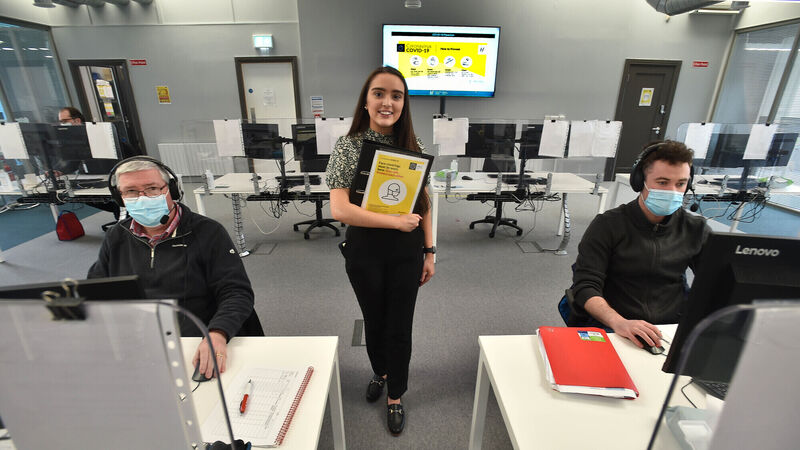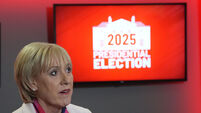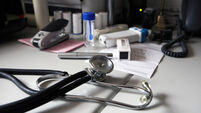Q&A: How does our contact tracing system work?

Team leader Keela Brogan at the Galway Contact Tracing Centre. Picture: Ray Ryan
As Ireland works its way painstakingly through its latest lockdown, different patterns are emerging in the countrywide Covid-19 picture.
As with the country’s experience last summer, some parts of the country are doing better in flattening their curves than others.
This brings up the issue of contact tracing, and not for the first time.
While the Covid-19 pandemic has seen unimaginably rapid advances in vaccine development, in other ways the strange times we find ourselves in have seen a reliance on practices that are many generations old – specifically social distancing and contact tracing, which were also recommended during the Spanish Flu pandemic post-1918.
While distancing indisputably can help in suppressing a contagious illness, the efficacy of contact tracing on a weary population is more open to scrutiny.
At its most fundamental, the practice sees people with a disease and their close contacts informed as to their status so they can isolate themselves and thus prevent the onward spread of infection.
There are about 800 contact tracers in Ireland at present, plus about a hundred public health tracers used generally to handle more complex cases, such as ones involving a language barrier or a person with a suspected mental illness.
Three kinds of calls are made:
- Call 1 sees a positive case informed of that status and given information about self-isolating;
- Call 2 sees the same positive case called, generally about an hour later, in order to collate their close contacts;
- Call 3 is to the close contacts of a positive case and is broadly used to ensure they are getting themselves tested;
- Call 3S is focused on specific events – generally, people deemed to have been close contacts on flights or in schools. These people can only be advised to seek a test.
No, at least not by the main cohort of tracers. They’re based at centres in Limerick, Cork, Galway and Dublin, and their workload is assigned by which of the three kinds of calls they’re making, not by locality.
Public health tracers will, however, often visit the scene of outbreaks, such as those in meat packaging plants.
Definitely, most likely thousands of them. On both occasions, tracers were instructed to stop contacting close contacts of positive cases in order to purge the backlog of positive cases.
Further, in late December, tracers were instructed not to ask people with the virus where they thought they might have picked it up in order to save time, while for several weeks, close contacts were not even offered a test.
This was, of course, at a time when the country was seeing many thousands of cases a day as the virus ran rampant and unchecked.
As lockdown got a handle on the surge, testing for close contacts was reintroduced on January 29, with call 3s resuming 12 days later.
The problem is the disparity between a quiet time and when the virus is on the march. The sheer speed at which a highly contagious illness can spread is difficult to countenance.
In both cases, the HSE knew the surge was imminent. But knowing it’s coming and containing it are not the same thing.
Broadly speaking, once cases reach the level of 1,500-2,000 a day, the system will be in trouble. And if they’ve gotten that high, they will invariably get a lot higher again before they fall.
That isn’t a matter for contact tracers – the data they collate is passed up the food chain in the HSE and Department of Health to where policy decisions get made.
Bear in mind though that, while some areas, particularly in Cork and Kerry, are doing very well, this current lockdown is the first in the time of the new variants of concern, which are significantly more transmissible than their predecessor.
Also worth remembering is that Ireland itself went from being the best in class in the EU in terms of the virus at the beginning of December to the worst just four weeks later.
Given that knowledge, the lifting of restrictions locally seems unlikely in the near future at any rate.
Yes. This lockdown has seen the reopening of schools after two months of closure. At present, tracers say school referrals are keeping them very busy, but it’s too early to say whether the opening has sparked a fresh wave of the virus.
You can expect the HSE, Nphet, and the Health Minister to play their cards very close to their chest until they know what effect the schools being open is having.
At this stage, it’s hard to say. At present, all cases and close contacts are being contacted alright, but as one source puts it: “If everyone who was supposed to be staying home was actually doing it, then the numbers would be falling a lot more quickly.”





